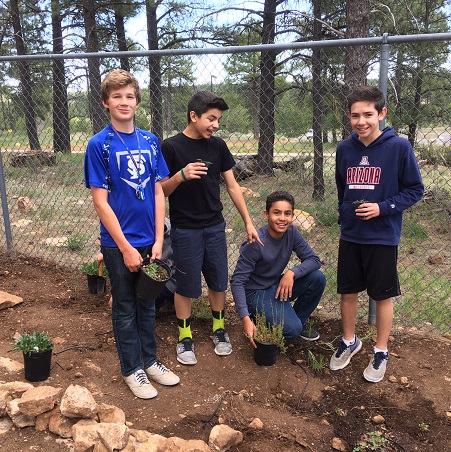|
|
Educator Resources
Here are some easy resources to help everyone learn more about monarch butterflies with a special
Southwest flavor!
Activities
Gardening for Monarchs & Pollinators
 Sinagua High School—Flagstaff, Arizona
Sinagua High School—Flagstaff, Arizona
|
- What to plant? See our handy website Waystation guide!
Learn all the
ingredients to make a
perfect garden banquet to draw monarchs and pollinators to your feast. Check out the
regional planting guides
to help you find the best plants for where you live in the Southwest.
Want to start native Southwest milkweeds from seed? Follow our easy
directions.
-
Seed balls are an easy way to spread much needed monarch and pollinator nectar and host plants. While
we all know milkweed is important for monarchs during the breeding season, rich nectar is key to supporting
the monarch migration. You can add native sunflowers and other native seeds to benefit many species. There
are many ways to make seedballs; here is one recipe You
can also find premade mixes online and just add your own seeds. The key is to use only 3 - 5 seeds per marble
size ball. Let the balls dry for 24 to 48 hours then have fun tossing them around! Wait for the rainy season
and enjoy. Need seed ideas? See our
regional planting guides and plants for restoration
for Arizona. (We hope to expand Restoration seed recommendations to other nearby Southwest states soon.)
-
Plan a butterfly garden for your school! Southwest Monarch Study will offer a new school Monarch Waystation Grant
program soon. If you are interested, contact us at info@swmonarchs.org
Resources:
- Southwest Monarch Study website: https://www.swmonarchs.org provides overviews of recent research in the Southwest United
States including monitoring and tagging long term data. Access to videos, recent findings and a link to
Status of Danaus plexippus in Arizona are included.
- Learn about monarchs in the West! Journey North offers tracking of the monarch migration. During the Spring
and Fall migrations, Gail Morris, Southwest Monarch Study Coordinator & Monarch Watch Conservation Specialist
writes a weekly column in Western Monarch News. There is also a special Educators link to provide classroom links
to monarch movement locally and around the country.
https://journeynorth.org/monarchs
-
See Monarch Butterfly Fund's
Monarch Fun Facts
-
Milkweed, Monarchs and More, A Field Guide to the Invertebrate Community in the Milkweed Patch by Ba
Rea, Karen Oberhauser, Michael A. Quinn. This is a wonderful resource to help identify the many critters both
children and adults may find on milkweed. Great opportunity to learn if they are helpful or a problem to
monarchs as well.
-
Monarchs and More—An Inquiry and Arthropod Based Curriculum Grades 3 - 6, Monarchs in the Classroom.
A rich resource of monarch and more activities that are geared for children grade 3 to 6.
-
Monarchs and More—An Inquiry and Arthropod Based Curriculum Middle School Monarchs in the Classroom.
-
Pollinator Partnership Pollination-Fast-Facts-Educators-Students
|


